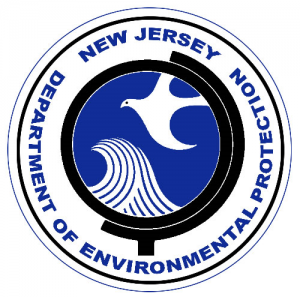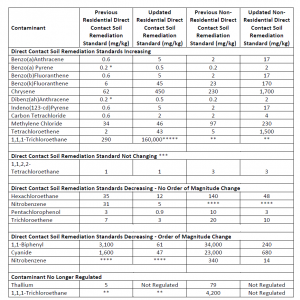The soil remediation standards for two of the most common contaminants, Tetrachloroethene (PCE) and Benzo(a)Pyrene (BaP), are becoming less stringent–a welcome relief to the regulated community.

On September 18, 2017, the New Jersey Department of Environmental Protection (NJDEP) published a Notice of Administrative Change in the New Jersey Register that updated the soil remediation standards for 19 contaminants in accordance with N.J.A.C. 7:26D-6.2. These updates reflect revisions to the toxicity information for these contaminants, as found in the United States Environmental Protection Agency (USEPA) Integrated Risk Information System (IRIS) database (see www.epa.gov/iris), on which the soil remediation standards are based. It should be noted that the default impact to ground water soil screening levels have not been updated for these contaminants and still must be considered when making site remediation decisions.
As shown by the table below, the existing soil remediation standards are affected as follows:
- The soil remediation standards for 11 contaminants are increasing (becomes less stringent);
- The soil remediation standards for 6 contaminants are decreasing (becoming more stringent);
- The soil remediation standard for 1 contaminant is unchanged; and
- One contaminant will no longer be regulated.
Of the 6 contaminants for which the soil remediation standards are decreasing, the soil remediation standards for 1,1-Biphenyl, Cyanide, Nitrobenzene are decreasing by an order of magnitude or more.
The updated soil remediation standards are operative as of September 18, 2017; however, for contaminants that have not decreased by an order of magnitude, the prior soil remediation standard can be used if a Remedial Action Work Plan or Remedial Action Report is submitted to the NJDEP by March 18, 2018.
For sites impacted by any of the three contaminants for which the soil remediation standard is decreasing by an order of magnitude or more, the updated remediation standards must be used, regardless of whether there is an approved Remedial Action Workplan or Remedial Action Report.

As BaP is often identified in “clean fill” just above 0.2 ppm, the increase of BaP from 0.2 ppm to 0.5 ppm in residential settings, and 0.2 ppm to 2 ppm at non-residential sites, should help responsible parties find additional facilities that can provide clean fill for capping purposes. The less stringent BaP standard should also reduce the number of sites that require a Deed Notice and/or Engineering Controls.
Owners of PCE contaminated properties are even more likely to jettison the need for a Deed Notice or Engineering Controls, as the residential soil standard is increasing from 2 ppm to 43 ppm, and the non-residential standard is rising from 5 ppm to 1,500 ppm.
If you have any questions, or would like more information regarding the new soil remediation standards, please contact our Senior Vice President, Michael Metlitz, LSRP.
 Michael Metlitz, LSRP
Michael Metlitz, LSRP
Senior Vice President
mmetlitz@whitmanco.com
Office: (732) 390-5858
Posted on September 29, 2017





